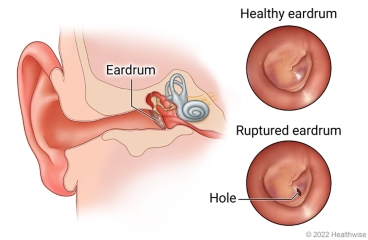
Overview
A tear or hole in the membrane of the middle ear is called a perforated or ruptured eardrum. This can happen if an infection builds up inside the ear or if the eardrum gets injured. Your child may find it hard to hear out of that ear or may hear a buzzing sound. Other symptoms may include an earache or fluid draining from the ear.
The eardrum should heal on its own in a few weeks, and your child should hear normally then. If your child has an infection, your doctor may prescribe antibiotics. Pain relief medicine may be needed for the earache.
Your doctor will check to see if the eardrum has healed. If not, your child may need surgery to repair the eardrum.
Follow-up care is a key part of your child's treatment and safety. Be sure to make and go to all appointments, and call your doctor if your child is having problems. It's also a good idea to know your child's test results and keep a list of the medicines your child takes.
How can you care for your child at home?
- If the doctor prescribed antibiotics for your child, give them as directed. Do not stop using them just because your child feels better. Your child needs to take the full course of antibiotics.
- Give your child an over-the-counter pain medicine, such as acetaminophen (Tylenol) or ibuprofen (Advil, Motrin) as needed. Be safe with medicines. Read and follow all instructions on the label.
- To ease pain, put a warm washcloth on your child's ear. There may be some drainage from the ear.
- Ask your doctor if you should give your child oral or nasal decongestants to relieve ear pain. These may help if a cold is causing fluid behind the eardrum. (Do not use products that have antihistamines in them, because these can cause more blockage.)
- Do not give decongestants to a child younger than 2 unless your child's doctor has told you to. If the doctor tells you to give a medicine, be sure to follow what your doctor tells you to do.
- Be careful when giving over-the-counter cold or flu medicines and Tylenol at the same time. Many of these medicines have acetaminophen, which is Tylenol. Read the labels to make sure that you are not giving your child more than the recommended dose. Too much Tylenol can be harmful.
- Keep your child's ears dry. Do not let your child swim or shower until your doctor says it's okay.
- Do not put anything into your child's ear canal. For example, do not use a cotton swab to clean the inside of the ear. It can damage the ear. If you think something is inside your child's ear, ask your doctor to check it.
When should you call for help?
Call your doctor now or seek immediate medical care if:
- Your child has signs of infection, such as:
- Increased pain, swelling, warmth, or redness.
- Pus draining from the ear.
- A fever.
Watch closely for changes in your child's health, and be sure to contact your doctor if:
- You notice changes in your child's hearing.
- Your child does not get better as expected.
Where can you learn more?
Go to http://www.healthwise.net/patientEd
Enter X335 in the search box to learn more about "Perforated Eardrum in Children: Care Instructions".
Current as of: September 27, 2023
Author: Ignite Healthwise, LLC Staff
Clinical Review Board
All Healthwise education is reviewed by a team that includes physicians, nurses, advanced practitioners, registered dieticians, and other healthcare professionals.

